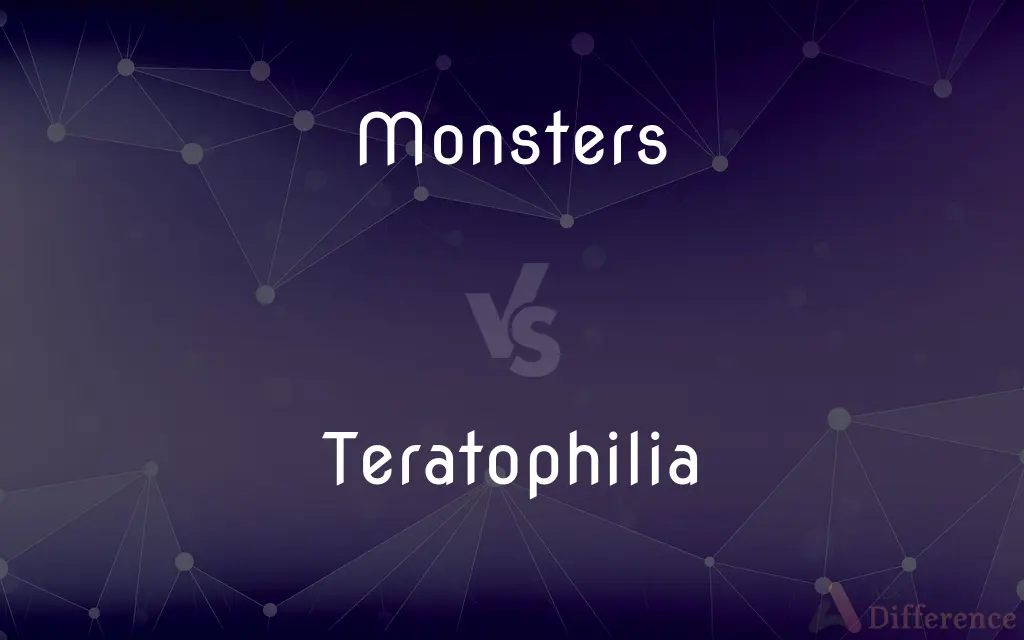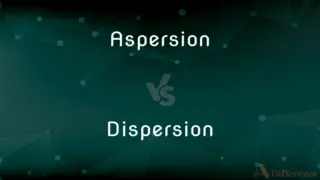Monsters vs. Teratophilia — What's the Difference?
By Tayyaba Rehman & Urooj Arif — Updated on April 23, 2024
Monsters are mythical or legendary creatures often depicted as frightening, while teratophilia refers to a attraction to monsters or deformed beings.

Difference Between Monsters and Teratophilia
Table of Contents
ADVERTISEMENT
Key Differences
Monsters are typically creatures from mythology, folklore, or horror fiction, known for their frightening appearance and supernatural abilities. Whereas teratophilia is a paraphilia where individuals experience attraction to monsters or beings with physical deformities.
Monsters often embody universal human fears and are portrayed as antagonists in stories and films, serving as a symbol of chaos or evil. On the other hand, teratophilia can involve a fascination with the monstrous or grotesque aspects of a creature, viewing them through a lens of attraction rather than fear.
The portrayal of monsters varies widely across cultures, often reflecting societal anxieties or moral lessons. Whereas teratophilia may not be widely discussed or understood, reflecting more on individual psychological conditions than on cultural storytelling.
In popular culture, monsters appear in various forms, from vampires and werewolves to more abstract or alien creatures designed to evoke horror and suspense. Conversely, teratophilia might manifest in attractions to characters in horror or fantasy genres who exhibit these monstrous traits.
While monsters serve as key figures in horror and fantasy genres, creating tension and intrigue, teratophilia is a niche interest that can influence personal relationships and perceptions of characters within these genres.
ADVERTISEMENT
Comparison Chart
Definition
Mythical or supernatural creatures often portrayed as frightening.
A attraction to monsters or beings with deformities.
Cultural Role
Symbols of fear, evil, or chaos in stories.
Rarely discussed publicly; focuses on personal psychological interests.
Representation
Varied across different media as villains or tragic figures.
Involved in personal attractions, often related to characters in media.
Psychological Aspect
Used to symbolize internal or external human fears.
Involves complex psychological dynamics, often considered a paraphilia.
Compare with Definitions
Monsters
Symbol of fear.
In many cultures, monsters are embodiments of primeval fears.
Teratophilia
Paraphilia.
Teratophilia involves a attraction to deformed or monstrous beings.
Monsters
Mythical creature.
Dragons are often depicted as powerful monsters in ancient myths.
Teratophilia
Psychological condition.
Teratophilia can be a complex and misunderstood condition.
Monsters
Horror film antagonist.
The monster in the movie terrified the town.
Teratophilia
Attraction pattern.
His teratophilia is influenced by his fascination with Gothic literature.
Monsters
Fictional villain.
The novel features a monster who is the embodiment of evil.
Teratophilia
Personal preference.
She explores her teratophilia through art and storytelling.
Monsters
Supernatural being.
Ghosts are considered ethereal monsters in many stories.
Teratophilia
Niche interest.
Her teratophilia is reflected in her choice of favorite movie characters.
Monsters
An imaginary or legendary creature, such as a centaur or Harpy, that combines parts from various animal or human forms.
Monsters
A creature having a strange or frightening appearance.
Monsters
(Archaic) An organism that has structural defects or deformities.
Monsters
(Informal) A very large animal, plant, or object.
Monsters
One who inspires horror or disgust
A monster of selfishness.
Monsters
(Informal) Extremely large; monstrous
A monster hit at the box office.
Ate a monster steak.
Monsters
Plural of monster
Common Curiosities
What are typical characteristics of monsters in folklore?
Monsters in folklore often have supernatural powers and are depicted as menacing or cursed beings.
Can monsters have positive roles in stories?
Yes, some stories depict monsters in positive or sympathetic roles, challenging traditional perceptions of monstrosity.
Is teratophilia considered a disorder?
Teratophilia is classified as a paraphilia, which can be considered a disorder if it causes distress or harm.
How do cultural perceptions of monsters vary?
Cultural perceptions of monsters vary widely, with some seeing them as evil incarnates and others as misunderstood beings.
What types of monsters are most commonly depicted in media?
Common monsters in media include vampires, zombies, werewolves, and mythical creatures like dragons.
Are there communities that embrace teratophilia?
Yes, there are niche communities and forums online where individuals with teratophilia share their interests.
How does teratophilia affect personal relationships?
Teratophilia can complicate personal relationships, especially if the attractions are central to an individual's gender.
Do monsters always represent something negative?
Not always; in some narratives, monsters are depicted as tragic heroes or victims of circumstance.
How does teratophilia manifest in individuals?
Teratophilia manifests as a romantic attraction towards beings that are monstrous or physically deformed.
What psychological theories explain the fascination with monsters?
Psychological theories suggest that monsters represent human fears, the unknown, and repressed desires.
Share Your Discovery

Previous Comparison
Cathy vs. Kathy
Next Comparison
Aspersion vs. DispersionAuthor Spotlight
Written by
Tayyaba RehmanTayyaba Rehman is a distinguished writer, currently serving as a primary contributor to askdifference.com. As a researcher in semantics and etymology, Tayyaba's passion for the complexity of languages and their distinctions has found a perfect home on the platform. Tayyaba delves into the intricacies of language, distinguishing between commonly confused words and phrases, thereby providing clarity for readers worldwide.
Co-written by
Urooj ArifUrooj is a skilled content writer at Ask Difference, known for her exceptional ability to simplify complex topics into engaging and informative content. With a passion for research and a flair for clear, concise writing, she consistently delivers articles that resonate with our diverse audience.














































